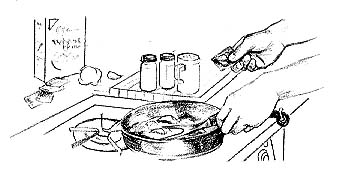IntroductionKitchen Magic with Mushooms, the first cookbook of the Mycological Society of San Francisco, was written in 1962 by the late Charles Sharp. It was very well received, not only by our members, but by other mushroom enthusiasts and professional chefs. In 1980 we decided it was time to write a second book to accommodate changing perspectives and a heightened interest in the preparation of wild and cultivated mushrooms for the table. This gave us the opportunity to check the recipes described in Kitchen Magic with Mushrooms for accuracy and to include mushrooms in this book that had been introduced to the public since the publication of the original cookbook. Recipes were requested and received from members of other groups as well as from our own society members. The remaining recipes are from the author's collection and Kitchen Magic with Mushrooms. The mushrooms presented in this cookbook were selected for their availability and safeness. Most recipes were planned for four servings. It was difficult to be exact in the amounts of mushrooms to be used in the recipes due to the varying sizes, shapes, and degrees of dryness of the mushrooms. Those who use these recipes will have to apply that cookbook judgment alluded to in the phrase "not too much, not too little." We experimented with many methods of preparation, with wines, and with various flavor enhancers. Our conclusion was that the simplest preparations were the best. We found that it was easy to overwhelm the delicate subtlety of most mushroom flavors. Our primary purpose was to enhance and highlight these qualities. The most exciting developments in the mushroom world today involve new methods of cultivation and the introduction of new species. As improved techniques are applied commercially, we are witnessing a great expansion in the mushroom industry. Colorful varieties such as the golden-brown butter mushroom, Pholiota aurivella, and the red-brown wine-cap mushroom, Stropharia rugosoannulosa, are starting to appear in produce markets. We hope that lower prices will make them more affordable. Many Asian mushrooms such as the shiitake mushroom, once limited to Asian stores, can be purchased in large supermarkets. In the past, we were only able to find Asian mushrooms dried and packaged, but now fresh forms such as shiitakes are making their welcome debut. We have learned that these mushrooms are as delicious in stews, casseroles, and sauces as they are in stir-fried dishes. And the cultivation of freshly grown wild mushrooms has been perfected for some varieties, allowing us to have readily accessible and delectable taste treats in our kitchens. Although this book may introduce the reader to untried and new mushrooms, we hope you will not overlook the tried and true ones. It is not in snobbery, but in praise, that we raise our noses to appreciate the aroma of the common store mushroom. We love and admire it for its generally robust flavor, firm texture, attractive appearance, availability, low cost, and capacity to combine with other foodstuffs, as well as its keeping quality. It pleases us to report that this kitchen Cinderella can be substituted in most of our recipes, and that it will be in season all year long and in any weather. All living things have been systematically named with two Latinized words. The first word refers to the general group with which the individual shares common characteristics, the genus. The second, the species name, refers to members of the group according to their individual features. The scientific name for the common store mushroom, for example, is Agaricus bisporus. Agaricus is the genus and bisporus is the species name. Common names have also been given to many mushrooms, but they vary from country to country and region to region. You can never be sure what kind of mushroom is referred to when someone tells you it's O.K. to eat a "slippery jack." Try to learn the Latin names. Knowing the scientific name will help you identify and discuss mushrooms with others. Try to learn one species at a time. In the long run, scientific names are more useful and less confusing than common names.  |